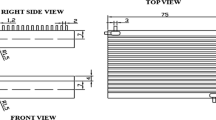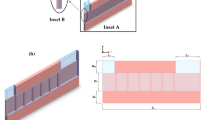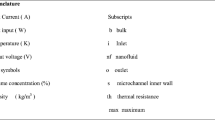Abstract
Forced convective heat transfer in a microchannel heat sink (MCHS) using CuO/water nanofluids with 0.1 and 0.2 vol% as coolant was investigated. The experiments were focused on the heat transfer enhancement in the channel entrance region at Re < 1800. Hydraulic performance of the MCHS was also estimated by measuring friction factor and pressure drop. Results showed that higher convective heat transfer coefficient was obtained at the microchannel entrance. Maximum enhancement of the average heat transfer coefficient compared with deionized water was about 40 % for 0.2 vol% nanofluid at Re = 1150. Enhancement of the convective heat transfer coefficient of nanofluid decreased with further increasing of Reynolds number.














Similar content being viewed by others
Abbreviations
- A:
-
Surface area (m2)
- Cp :
-
Specific heat (J/kg K)
- Dh :
-
Hydraulic diameter (m)
- f:
-
Fanning friction factor
- h:
-
Heat transfer coefficient (W/m2K)
- Hch :
-
Height of microchannel (µm)
- Htc :
-
Distance from thermocouple to the base of microchannel (mm)
- K:
-
Thermal conductivity (W/m K)
- Lch :
-
Microchannel length (mm)
- ṁ:
-
Mass flow rate (g/s)
- Nu:
-
Nusselt number
- n:
-
solid particle shape factor
- N:
-
Number of microchannel
- Pr:
-
Prandtl number
- Δpnet :
-
Net pressure drop along microchannels (bar)
- Δpmeasured :
-
Total pressure drop (bar)
- Δpc1, Δpc2 :
-
Contraction pressure loss (bar)
- Δpe1, Δpe2 :
-
Expansion pressure loss (bar)
- qf :
-
Heat transfer rate remove by fluid (W)
- q˝conv. :
-
Heat flux through heat sink base area by convection mechanism (W/m2)
- Re:
-
Reynolds number
- T:
-
Temperature (°C)
- u̅:
-
Average fluid velocity (m/s)
- uin :
-
Fluid inlet velocity (m/s)
- uout :
-
Fluid outlet velocity (m/s)
- wch :
-
Microchannel width (µm)
- wfin :
-
Fin width (µm)
- x:
-
Axial distance (mm)
- η:
-
Fin efficiency
- µ:
-
Viscosity
- ρ:
-
Density
- φ:
-
Volumetric fraction of nanoparticles
- ave:
-
Average
- b:
-
Bulk
- bf:
-
Base fluid
- ch:
-
Microchannel
- fin:
-
Fin
- in:
-
Inlet
- nf:
-
Nanofluid
- out:
-
Outlet
- p:
-
Solid particles
- s:
-
Solid metal for heat sink
- w:
-
Wall
- x:
-
Local condition
References
Han Z (2008) Nanofluids with enhanced thermal transport properties. Ph.D. thesis, University of Maryland at College Park, Maryland
Keblinski P, Eastman JA, Cahill DG (2005) Nanofluids for thermal transport. Mater Today 8(6):36–44
Tuckerman DB, Pease R (1981) High-performance heat sinking for VLSI. Electron Device Lett IEEE 2(5):126–129
Garimella SV, Sobhan C (2003) Transport in microchannels—a critical review. Annu Rev Heat Transf 13:1–50
Eastman JA, Phillpot S, Choi S, Keblinski P (2004) Thermal transport in nanofluids. Annu Rev Mater Res 34:219–246
Mohammed HA, Bhaskaran G, Shuaib NH, Saidur R (2011) Heat transfer and fluid flow characteristics in microchannels heat exchanger using nanofluids: a review. Renew Sustain Energy Rev 15(3):1502–1512
Peyghambarzadeh S, Hashemabadi S, Jamnani MS, Hoseini S (2011) Improving the cooling performance of automobile radiator with Al2O3/water nanofluid. Appl Therm Eng 31(10):1833–1838
Peyghambarzadeh SM, Hashemabadi SH, Naraki M, Vermahmoudi Y (2013) Experimental study of overall heat transfer coefficient in the application of dilute nanofluids in the car radiator. Appl Therm Eng 52(1):8–16. doi:10.1016/j.applthermaleng.2012.11.013
Vakili M, Mohebbi A, Hashemipour H (2013) Experimental study on convective heat transfer of TiO2 nanofluids. Heat Mass Transf 49(8):1159–1165
Fotukian S, Nasr Esfahany M (2010) Experimental study of turbulent convective heat transfer and pressure drop of dilute CuO/water nanofluid inside a circular tube. Int Commun Heat Mass Transf 37(2):214–219
Choi SUS, Eastman J (1995) Enhancing thermal conductivity of fluids with nanoparticles. Argonne National Lab, Lemont, IL
Choi SUS (1998) Nanofluid technology: current status and future research. Argonne National Lab, Lemont, IL
Eastman J, Choi U, Li S, Soyez G, Thompson L, DiMelfi R (1999) Novel thermal properties of nanostructured materials. J Metastable Nanocryst Mater 2:629–634
Choi S, Zhang Z, Yu W, Lockwood F, Grulke E (2001) Anomalous thermal conductivity enhancement in nanotube suspensions. Appl Phys Lett 79(14):2252–2254
Eastman J, Choi S, Li S, Yu W, Thompson L (2001) Anomalously increased effective thermal conductivities of ethylene glycol-based nanofluids containing copper nanoparticles. Appl Phys Lett 78(6):718–720
Mirzaei M, Dehghan M (2013) Investigation of flow and heat transfer of nanofluid in microchannel with variable property approach. Heat Mass Transf 49(12):1803–1811
Chein R, Huang G (2005) Analysis of microchannel heat sink performance using nanofluids. Appl Therm Eng 25(17):3104–3114
Sivakumar A, Alagumurthi N, Senthilvelan T (2015) Experimental investigation of forced convective heat transfer performance in nanofluids of Al2O3/water and CuO/water in a serpentine shaped micro channel heat sink. Heat Mass Transf 1–10. doi:10.1007/s00231-015-1649-5
Nguyen CT, Roy G, Gauthier C, Galanis N (2007) Heat transfer enhancement using Al2O3–water nanofluid for an electronic liquid cooling system. Appl Therm Eng 27(8):1501–1506
Zhigang L, Ning G, Takei M (2007) An experimental investigation of single-phase heat transfer in 0.045 mm to 0.141 mm microtubes. Nanoscale Microscale Thermophys Eng 11(3–4):333–349
Ho CJ, Wei LC, Li ZW (2010) An experimental investigation of forced convective cooling performance of a microchannel heat sink with Al2O3/water nanofluid. Appl Therm Eng 30:96–103
Chein R, Chuang J (2007) Experimental microchannel heat sink performance studies using nanofluids. Int J Therm Sci 46(1):57–66
Lee J, Mudawar I (2007) Assessment of the effectiveness of nanofluids for single-phase and two-phase heat transfer in micro-channels. Int J Heat Mass Transf 50(3):452–463
Agwu Nnanna A (2010) Thermo-hydraulic behavior of microchannel heat exchanger system. Exp Heat Transf 23(2):157–173
Byrne MD, Hart RA, da Silva AK (2012) Experimental thermal–hydraulic evaluation of CuO nanofluids in microchannels at various concentrations with and without suspension enhancers. Int J Heat Mass Transf 55(9–10):2684–2691. doi:10.1016/j.ijheatmasstransfer.2011.12.018
Selvakumar P, Suresh S (2012) Convective performance of CuO/water nanofluid in an electronic heat sink. Exp Therm Fluid Sci 40:57–63. doi:10.1016/j.expthermflusci.2012.01.033
Moffat RJ (1988) Describing the uncertainties in experimental results. Exp Therm Fluid Sci 1(1):3–17
Wang XQ, Mujumdar AS (2008) A review on nanofluids-part I: theoretical and numerical investigations. Braz J Chem Eng 25(4):613–630
Maxwell JC (1873) A treatise on electricity and magnetism, vol 1. Oxford University Press, Oxford
Einstein A (1906) A new determination of the molecular dimensions. Ann Phys 19:289–306
Batchelor G (1976) Brownian diffusion of particles with hydrodynamic interaction. J Fluid Mech 74(01):1–29
Nguyen C, Desgranges F, Roy G, Galanis N, Mare T, Boucher S, Angue Mintsa H (2007) Temperature and particle-size dependent viscosity data for water-based nanofluids–hysteresis phenomenon. Int J Heat Fluid Flow 28(6):1492–1506
Hamilton R, Crosser O (1962) Thermal conductivity of heterogeneous two-component systems. Ind Eng Chem Fundam 1(3):187–191
Holman JP (1986) Heat transfer. McGraw-Hill, New York
Qu W, Mudawar I (2002) Experimental and numerical study of pressure drop and heat transfer in a single-phase micro-channel heat sink. Int J Heat Mass Transf 45(12):2549–2565
Kays W, London A (1984) Compact heat exchangers. McGraw-Hill, New York
Keblinski P, Phillpot S, Choi S, Eastman J (2002) Mechanisms of heat flow in suspensions of nano-sized particles (nanofluids). Int J Heat Mass Transf 45(4):855–863
Ahmad T, Hassan I (2010) Experimental analysis of microchannel entrance length characteristics using microparticle image velocimetry. J Fluids Eng 132(4):1–13. doi:10.1115/1.4001292
Gamrat G, Favre-Marinet M, Asendrych D (2005) Conduction and entrance effects on laminar liquid flow and heat transfer in rectangular microchannels. Int J Heat Mass Transf 48(14):2943–2954. doi:10.1016/j.ijheatmasstransfer.2004.10.006
Jung JY, Oh HS, Kwak HY (2009) Forced convective heat transfer of nanofluids in microchannels. Int J Heat Mass Transf 52(1):466–472
Israelachvili JN (1992) Intermolecular and surface forces. Academic press, New York
Godson Asirvatham L, Raja B, Mohan Lal D, Wongwises S (2011) Convective heat transfer of nanofluids with correlations. Particuology 9(6):626–631
Li Q, Xuan Y (2002) Convective heat transfer and flow characteristics of Cu-water nanofluid. Sci China Ser E Technol Sci 45(4):408–416
Maïga SEB, Palm SJ, Nguyen CT, Roy G, Galanis N (2005) Heat transfer enhancement by using nanofluids in forced convection flows. Int J Heat Fluid Flow 26(4):530–546
Xuan Y, Roetzel W (2000) Conceptions for heat transfer correlation of nanofluids. Int J Heat Mass Transf 43(19):3701–3707
Wu X, Wu H, Cheng P (2009) Pressure drop and heat transfer of Al2O3-H2O nanofluids through silicon microchannels. J Micromech Microeng 19(10):105020
Azizi Z, Alamdari A, Malayeri MR (2016) Thermal performance and friction factor of a cylindrical microchannel heat sink cooled by Cu-water nanofluid. Appl Therm Eng 99:970–978
Peyghambarzadeh SM, Hashemabadi SH, Chabi AR, Salimi M (2014) Performance of water based CuO and Al2O3 nanofluids in a Cu–Be alloy heat sink with rectangular microchannels. Energy Convers Manag 86:28–38
Salimi GM, Peyghambarzadeh SM, Hashemabadi SH, Chabi A (2015) Experimental investigation of convective heat transfer of Al2O3/water nanofluid through the micro heat exchanger. Modares Mech Eng 15(2):270–280
Azizi Z, Alamdari A, Malayeri MR (2015) Convective heat transfer of Cu–water nanofluid in a cylindrical microchannel heat sink. Energy Convers Manag 101:515–524
Author information
Authors and Affiliations
Corresponding author
Rights and permissions
About this article
Cite this article
Chabi, A.R., Zarrinabadi, S., Peyghambarzadeh, S.M. et al. Local convective heat transfer coefficient and friction factor of CuO/water nanofluid in a microchannel heat sink. Heat Mass Transfer 53, 661–671 (2017). https://doi.org/10.1007/s00231-016-1851-0
Received:
Accepted:
Published:
Issue Date:
DOI: https://doi.org/10.1007/s00231-016-1851-0




